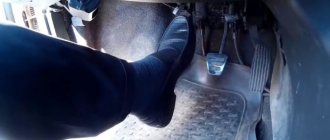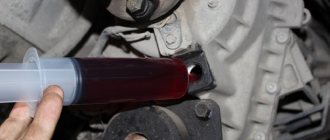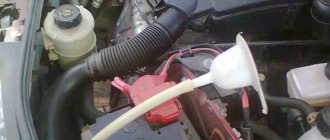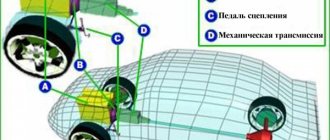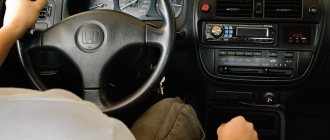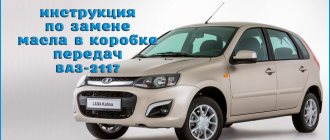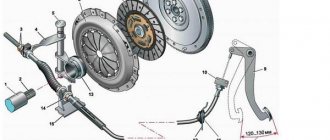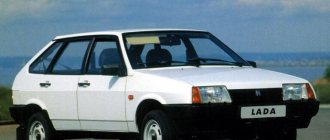Advertisement
A pedal is a footrest or lever that is pressed by the foot. The manual transmission is the foundation of the basics. The pedals on it have the most standard and common shape and location. The very first cars were equipped with “mechanics” - a manual transmission. People got used to it, to its features: changing gears, “manual” control over the state of the car, they got used to feeling like a full owner in it. For these reasons, we will consider the location of the pedals on a manual transmission.
But this feeling requires a lot of effort and work. So, what knowledge should a beginner who wants to master a car with a manual transmission have? First, he needs to thoroughly study the machine’s control unit and its main components: pedals and lever.
At a driving school, the standard curriculum includes the study of clutch pedals. And this is very correct. How well you “operate” the pedals in a car depends on your level of professionalism regarding driving a car. You must be able not only to manipulate the car’s controls, know where they are located, etc., but also understand what happens when they are pressed in the mechanisms - this makes it easier to develop qualities thanks to which you begin to literally “feel” your car. If you develop these qualities in yourself, then this can be very useful to you later.
Advertisement
In this article we will look at the location of pedals in a car, their types and what function each pedal performs.
Location
The pedals are arranged in the same order. Regardless of whether the transmission is manual or automatic. Automatic machines, robots and CVTs have two pedals instead of three. Because there is no need to disengage the clutch.
An interesting fact: in right-hand drive cars that are driven in Japan and the UK, and sometimes found here, the position of the pedals coincides with the left-hand drive cars we are used to. And not in a mirror image, as some might imagine.
Car with manual transmission
Cars equipped with manual transmission have three pedals. The arrangement of the mechanic's pedals is as follows.
- Clutch . The clutch is controlled by the pedal on the far left. Disengaging the clutch makes switching between gears easier and reduces the load on the gearbox parts.
- Brake. The pedal in the middle causes the car to slow down and is called a brake. Pressing it engages the car's braking system, preventing the wheels from rotating. At the same time, the speed decreases until it stops.
- Gas. The farthest pedal on the right side is gas. Pressing it causes increased engine operation and acceleration of the car. The acceleration speed directly depends on the pressing force. It is recommended to apply pressure gradually and smoothly.
A little history
For the first time, control mechanisms that had at least some resemblance to modern cars were used in Ford T cars. This was the first car that came off the assembly line and was put into production. It was with this car that the era of automobile construction began, and the capital of Henry Ford was launched.
This car's control system was very different from all previous cars. Car enthusiasts of that time were quite surprised by such “know-how”. For the first time, the car began to be started using a key rather than a button. It also added three pedals:
- The leftmost pedal was intended for traction when changing gears.
- The middle pedal was responsible for reverse.
- The one on the far right was analogous to a modern brake.
There was no gas pedal; its function was performed by a lever located where the gearbox selector is now located.
You can learn more about the Ford Model T from this video:
Automatic machine
There are only two pedals in an automatic car, because disengaging the clutch is not required. Gears change automatically.
- Brake. The pedal on the far left will be the brake. It is larger than in a manual car.
- Gas. The pedal on the right is gas.
The location of the automatic pedals is the same as that of the manual.
Functional Features
Having studied the features of the location of the pedals in cars with a manual transmission, it will not be difficult to finally remember where each is. Each of you understands that the pedals in the car play a certain role. Everyone has their own strictly assigned function. And they need to be taken into account when getting behind the wheel.
Let us remind you how the pedals in any car go from left to right on the driver’s side:
In an automatic transmission, everything goes exactly the same way, but only with the condition that there is no clutch in this sequence.
To better understand the functional features, you need to consider all the pedals separately.
Clutch
It's easy to remember where the clutch lever is located in your car. It is important to take into account that on all cars they are always in the same place. Car companies cannot place the clutch on the right or in the middle.
Now let’s talk more specifically about why such a control lever in a car as a clutch pedal is needed. Responsible for the connection between the gearbox and the engine, as well as disconnection as necessary. If the pedal is not touched, the engine will be connected to the gearbox, that is, at this time the clutch is considered to be engaged.
When the control lever is pressed to the floor, disengagement occurs and therefore the clutch is disengaged. In order for the car to start moving, the driver must turn the clutch back on. And to do this, simply release the pedal.
If you take into account the design, everything happens as follows:
- the clutch disc consisting of a pair of discs is located on the splines of the input shaft of the box, a rigid connection is used;
- in this case, the disk is clamped between the motor flywheel and the basket rings;
- when the pedal is pressed, a special spring releases the ring located on the basket;
- the ring moves away from the flywheel;
- the disk is released and it begins to rotate independently of this flywheel;
- now the driver changes gear and then releases the pedal;
- at the same time, the spring is released by the release bearing, the rings come back together, and the disk is clamped again.
This happens quickly and cyclically with every gear shift on a manual transmission.
When operating a car with a manual transmission, that is, if there is a clutch in the form of a pedal, you must adhere to some rules:
- You should always keep your left foot near the pedal so that you can press it at any time. Most cars are equipped with platforms to the left of the pedal, which is intended for the left foot and its rest between shifts. The main thing is to take a comfortable position so that your leg does not get tired.
- You don't have to keep your foot on the pedal all the time. Otherwise, the driver gets tired and the clutch itself wears out faster. Any even slight pressure creates a load, and therefore wear occurs.
- Always depress the control lever fully when changing from one speed to another.
- The left foot is used only to operate one pedal. And it's purely clutch.
- Pressing should be done completely, quickly, but without jerking. Try to do everything in one movement. This is where how comfortably you hold your foot comes into play.
- When you smoothly release the pedal, traction begins and the car moves. At this moment, you should stay in this position and drive literally 3 meters. This holding of the leg in the middle position is the optimal starting point. If you miss this moment, sharply remove the pedal or press the gas too quickly, you will end up slipping, the car will start to twitch and will probably stall. It is recommended to practice the start as much as possible. You need to get used to each specific car.
- Be sure to disengage the clutch before starting the engine. To do this, the pedal is pressed to the floor. Only then does the starter turn on.
- The clutch is used in three situations. This is the start of movement, switching gears and stopping completely.
It is the clutch that makes driving cars with manual transmission more difficult when compared with automatic transmission. But you get used to everything and you can learn everything.
Having the skills to control a manual transmission with a clutch pedal, switching to an automatic transmission will not be difficult. But if you learned to drive an automatic transmission, and then had to switch to a manual transmission, you can feel as if you were behind the wheel for the first time.
Brake
You already know where the brake pedal should be located in the car. If in a car with a manual transmission, then in the middle, and if with an automatic transmission, then on the left.
By pressing this control lever, the driver thereby transfers the load to the amplifier. It creates additional force on the master brake cylinder installed in the car. By releasing the pedal, the return spring allows you to return the element to its original position.
There is nothing complicated in the design of this component. This is a lever with a special platform for the foot on the bottom side. There are also a couple of holes near the top end. Through one hole passes a pin that allows the pedal to move back and forth in a confined space.
The second hole is needed to connect the vacuum booster to the plug. If there is no booster, then there is a connection to the master cylinder of the brake system. To create a reliable and movable connection, metal pins are used.
When the driver presses this pedal, any car is designed to automatically turn on the brake lights located behind the car.
It is also an accelerator or accelerator pedal. Here you should also understand what the accelerator pedal in a car is and how it works.
The element is designed to give the car acceleration. This is achieved by opening the throttle valve and increasing the amount of fuel entering the combustion chamber. The harder the driver presses the control lever, the more air-fuel mixture enters the combustion chamber. It is only important to take into account the fact that traditional and electronic pedals can be installed on cars.
If this is a mechanical standard pedal, then the design includes a cable drive for the damper. When the driver squeezes the element, the cable opens the throttle valve. The opening occurs exactly at the angle at which the cable rod was pressed.
With an electronic pedal, things are a little different. When you press the control lever to accelerate, a special sensor reads information about the angle of pressure and transmits it to the motor control unit. The block itself determines at what angle the throttle valve should be opened, after which it transmits the corresponding command to the actuator, that is, the drive.
Mechanical pedal operation
In a car with a manual transmission, turn off the handbrake. Then start the engine. To do this, turn the ignition key in the lock until it stops. After this, press the clutch and switch to first gear.
After which the clutch is released and the car begins to move. Next, the gas is smoothly squeezed out, and as it accelerates, gears are changed after pressing the clutch.
Gears must be changed both when accelerating and when decelerating. The stages are switched in order so as not to break the box and not throw the engine out of rhythm.
Gas, brake, clutch - must work as one team, otherwise there will be jerks, jerking of the car, and the engine will stall. When switching gears incorrectly or inconsistently, the gearbox crunches.
Explore the gearbox
When the engine is not yet started, move the gearshift lever. The speeds on the lever are arranged in an "H" shape. However, the return stroke in the box will be located differently in different levers. In this case, such a reverse move is to the right and down.
Operation of automatic pedals
Automation control is much easier. There is no need to constantly disengage the clutch; the gears switch themselves in the required sequence using special clutches.
The lever only turns on the “D” mode for moving forward. Or “R”, for reversing the car. There may also be modes “P” - for long-term parking and “N” - corresponding to neutral gear for manual transmission.
Pressing the gas after starting the engine causes the car to move in the desired direction. The force applied to the brake pedal is transmitted to the braking system and safety systems such as ABS. The braking device is much more complex than a manual one.
Emergency maneuverability
Typically, manual driving lessons for beginners are conducted in a calm environment and on a flat surface. However, on a real road, surprises occur after every turn. Therefore, a beginner should practice emergency maneuverability skills so as not to lose his head in a dangerous situation. The exercises are as follows:
- braking - the driver accelerates and brakes sharply;
- avoiding obstacles - tires are laid out on the site and the driver must go around them at the last moment;
- recovery from a skid - the driver brakes sharply on a slippery surface.
While doing the exercises, remember how the car behaved in a critical situation. Manual driving training takes place at the SAI driving school in Yekaterinburg. We offer in-person and distance learning for driver's licenses. Visiting hours are morning and evening. Call and fill out an application for driving courses!
Which foot to press
The key to safe driving is pressing the pedals correctly with the right foot.
Important rule: You should always press the clutch pedal with your left foot, and brake and gas only with your right foot.
If we conditionally divide the foot into three segments, this will allow us to more accurately explain the rule:
- the front part of the foot, as the most sensitive, presses the gas;
- the middle part, harder and stronger, on the brake or clutch;
- the heel is not used, this part is the least sensitive, and it is extremely inconvenient to work with.
Attention: shoes are an important part of pedal control. To operate the car, you need comfortable shoes in which you can “feel” the pedals well. The shoes are tight and loose on the foot.
The soft sole of some running shoes reduces this sensation, which prevents you from pressing the pedals with the necessary effort and increases the risk of getting into an accident.
You cannot drive a car in shoes with long heels (this applies to women). The cause of the accident may be that your heel gets under the brake pedal, which prevents you from pressing it all the way.
There are those who like to argue about the possibility of pressing the brake with the left foot in cars equipped with automatic transmission, since there are two pedals. It's a matter of convenience and driver habit. If you are used to braking with your right hand, it will be difficult to relearn, it is better to leave it as is, so as not to mix up the pedals.
❂ How to properly drive an automatic car in traffic jams ❂
During short stops, for example, at a traffic light, you need to leave the lever in the same position, most often it will be “D”, and hold the car with the brake pedal. When stopping for a long time with the engine running, the lever must be set to the “N” position.
Stop on the rise
If you stop the car on an incline, you should hold it down not by pressing the gas pedal, but by pressing the service brake - this will avoid unnecessary overheating of the transmission.
When maneuvering when parking in a limited space, for example, when entering a garage, you need to adjust the speed by slightly releasing the brake pedal. When the brake pedal is pressed, under no circumstances should you apply too much gas.
"S" mode
To the left of the selector mode designation is a program switch. In the forward position, the "S" symbol is visible. Some people think this is a sports mode. God bless you, what kind of sport mode does a regular road car have? Mode “S” is “standard” and is intended for all standard driving situations.
- When working energetically with the gas pedal (the “lot of gas” position), the engine will twist the maximum number of turns in each gear, providing intense acceleration;
- at the start, pressing the gas pedal sharply will engage first gear;
- When pressed smoothly, the movement will begin from second gear.
Mode "E"
The letter “E” (the program switch is moved to the rear position) means that the economy mode is turned on. Shifting to a higher or lower gear is performed by pressing the accelerator pedal firmly at a lower speed, at a lower engine speed, than in the “S” position.
This means that the engine will not reach maximum speed, providing a quiet, extremely comfortable and economical driving mode (which is necessary, for example, on slippery roads).
The first time you press the accelerator pedal all the way, program “E” is automatically reset to position “S”. This is explained simply: situations may arise in which it is necessary to accelerate intensively (for example, when overtaking).
It is clear that the artificial limitation of dynamics by the economy mode interferes with this, which means that in an extreme situation it should be automatically removed.
Pressing two pedals
Such misfires happen to both amateur and professional drivers - they press the gas and brake at the same time. What are the possible consequences:
- when you simultaneously press the gas and brake on a manual, it breaks first the clutch discs (the linings burn and crumble, the metal turns blue and loses strength), then the gearbox gears;
- for an automatic it’s generally fatal, the torque converter burns out almost immediately;
- Some modern machines and robotic boxes have protection against such clicks. They react to such a situation as if they were applying a brake;
- a similar reaction is intended for racing cars. This allows riders to brake without taking their foot off the gas.
How to drive an automatic car in winter
Many car owners do not wonder how to properly drive an automatic transmission in winter, but in vain - the main problems arise precisely with the onset of cold weather. Here we will outline the main rules and tips for the safe operation of a car with an automatic transmission in winter.
Pros and cons of automatic transmission in winter
Pros:
The main advantage of the automatic transmission is its smooth operation and seamless integration with numerous and different electronic “assistants”. An automatic transmission is more reliable when driving on ice compared to a manual transmission: the risk of slipping in this case is much lower.
Of the minuses:
The main disadvantage is that the automatic transmission is not always able to accurately select the gear that the moving vehicle needs at the moment. This happens when the fluid coupling is late in detecting the discrepancy between engine speed, driving speed and driving resistance. Drivers, in response to this behavior of the car, begin to use a “pull” driving style.
Warming up the automatic transmission
In cold weather, before you start driving, you need to warm up the car engine. This applies equally to the automatic transmission. To warm up, with the lever in the “Drive” position and the brake pedal fully depressed, you need to lightly press the gas pedal for about 15 seconds.
Next you need to perform the same action, but in the “Reverse” position. This warming up takes no more than 3 minutes.
To warm up the automatic transmission, it is also recommended to drive slowly for about 3 kilometers
Descent to automatic transmission
Constantly braking on descents is unacceptable, as there is a danger of overheating the automatic transmission. It is much safer to “slow down” the movement so that the automatic transmission switches to a lower gear and the car continues to move under the influence of its weight.
When stopping on descents, simultaneously with the “Parking” mode, you need to use the handbrake, since the gearbox bears the load created by the weight of the entire car. If the parking brake is not used when stopping on descents, this will shorten the life of the automatic transmission.
How to overcome a snowdrift
You need to remember that it is best to overcome snowdrifts in 2nd gear, and not at all in the “Drive” gear. The vast majority of modern automatic transmissions have a mode for manual gear shifting, which, in snowdrift conditions, is more effective than other modes.
If you don’t use manual mode, then all you have to do is get into the swing. For this purpose, you need to smoothly press the gas pedal and, at the same time holding the car with the brake pedal, begin to climb forward. The backward movement is done in the same way. But do not overdo it: if you carry out the described actions for a long time, you can damage the gearbox.
Another nuance when overcoming snowdrifts is that you must turn off the ESP exchange rate stabilization (stability) system, which is absolutely useless if the car is stuck in a snowdrift.
In order not to go into a skid, you need to sharply release the gas pedal, while turning the steering wheel in the direction of the skid and return it to its original position.
How to park your car on a winter night
It often happens that the car cannot move in the morning because the parking brake froze in the on position at night. This most often occurs when there is snow or ice accumulation near the rear brakes or when the brakes are wet (for example, parking in a snowbank).
In this case, you won’t envy the driver: even if you add gas and stretch the handbrake, frozen rear pads can bend the discs.
That is why, if there is a risk of the handbrake freezing, it is better to limit yourself to putting the gear shift lever in the “P” position.
We recommend performing the following sequence of actions when parking your car:
- park the car overnight on level ground, without a slope,
- use automatic transmission mode “P” for parking,
- do not put the car on the handbrake.
By completing these steps, you will relieve tension from the parking gear of the automatic transmission. This voltage appears in the following case: when the car stopped on a slope, and further movement was blocked by setting the automatic transmission handle to the “P” position.
If after this you also put the car on the parking brake, this voltage will not disappear, but on the contrary, it will also be recorded by the handbrake.
